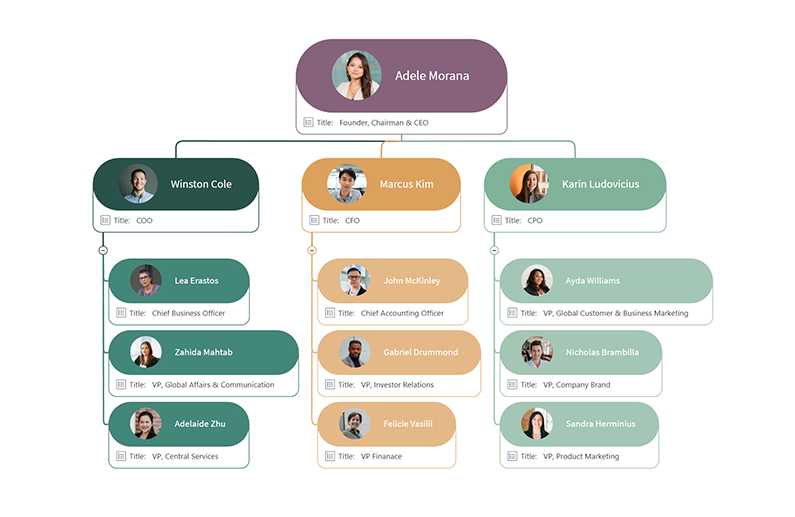
A functional chart (or org chart) organizes workers in a business based on skills, expertise, and specialty. It also shows the basic hierarchy of the organization, with the head of the business at the top followed by the top decision-makers. Employees are stationed under certain managers based on their job descriptions.
For example, an IT specialist would be responsible for software updates and computer security, while someone in HR would be responsible for employee onboarding, training, and complaints. The functional chart would display this information in a graphical format.
A functional chart could contain employee names and contact information, employee photos, reporting hierarchy, business divisions, and much more.
Ultimately, functional charts create a visual diagram for people to understand the structure of a company.
Scale your company by using MindManager to help your organization work better together. Sign up for MindManager for 30 days free!
There are four types of functional charts: Final top-down, divisional structure, matrix, and flat.
If you’re looking to create any of these types of functional charts, use MindManager hierarchy organizational template after you sign in as a starting point.
Diagramming the functional organization using a functional top down approach allows all employees to see which responsibilities lie with which business groups and how they can address concerns or questions.
Using a flat functional chart shows no levels of management. The goal of this flat chart is to empower employees to self-manage. Flat charts work well for small businesses.
When preparing for a divisional functional chart, you start by visually mapping out the product lines or geography.
A matrix functional chart focuses on a company organization structure segmented by projects. It works well for cross-functional teams and helps to minimize silos.
Creating a functional chart is just as easy as creating any type of mind map.
To make a functional chart using MindManager, follow the steps below.
Sign in to your MindManager account.
Choose one of the MindManager templates. For this example, we are choosing the hierarchy org chart template.
Start at the top. Begin with the top level of the hierarchy and work your way down, so it creates a branching tree shape. The highest level of the organization sits at the top, usually the CEO or Chair.
Move down first. The next level down will often be the senior managers or heads of department, and their departments will branch down and feature various managers and members of the teams.
Get more detailed. Once you have the central pillar you can start moving across, branching out to other suppliers and teams, like temporary staff and freelancers.
Share the functional chart. Once you have created your functional chart, post it up somewhere that’s easy for other teams to find and reference it.
With MindManager, build a high-quality functional chart for everyone in a few clicks of a button.
Add images from a library of over 700 assets and customize it quickly with your own brand elements.
MindManager integrates seamlessly with other tools such as Google Docs, OneDrive, and Teams. Its templates let you create functional charts quickly and easily by dragging and dropping elements.
By incorporating MindManager into your suite of tools, you can use it to create a snapshot of your entire organization or a specific team(s) for easy reference.
Functional charts visually display how your business or organization is laid out without overcomplicating who everybody is and what they are responsible for.
Functional charts work best when kept as simple as possible, and a tool like MindManager will enable you to put together a clear and concise functional chart in moments that you can then print or share digitally (or both).
Scale your company by using MindManager to help your organization work better together. Sign up for MindManager for 30 days free!
Creating functional charts in MindManager is easy and intuitive. Simply choose a pre-made template and follow our steps for making a flowchart. To get started making your own web diagrams, try MindManager free for 30 days.